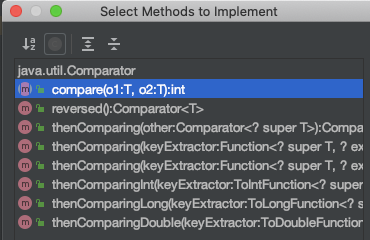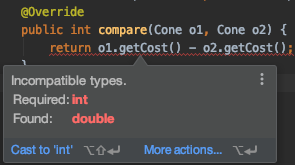Exercises: Interfaces and Polymorphism
Exercises
As a new Java coder, it might take you some time to recognize the usefulness of interfaces. At first glance, these tools do not seem to provide much benefit over extending a base class, adding instance methods to a class, or overriding a method like toString.
To help overcome this, let’s consider a common occurrence—sorting an ArrayList of objects.
If the list contains String or numerical entries, then sorting the list is trivial
:
Collections.sort(arrayListName);However, if the elements are custom objects (like Cat), then sorting the list becomes more complicated. This is because the objects may contain multiple fields, any of which could be used as a sorting option. For Cat objects, this could include name, age, or mass.
Getting Started
Work on these exercises in the IntelliJ java-web-dev-projects. You will find the starter code in the exercises package of the interfaces directory. Go ahead and open the folder and take a quick look at the class files.
You will practice implementing interfaces by playing around with a small ice cream store. It consists of a refrigerated display Case, which contains a collection of ice cream Flavor objects and a selection of Cone objects.
Did you notice the abstract Ingredient class? This gets extended into Flavor and Cone to help streamline the code.
1. Sorting Flavors by Name
To display a menu for your customers, you need to sort the ice cream flavors alphabetically by their name field. Fortunately, the Comparator interface helps you solve the sorting-objects-by-field problem.
Create a Sorting Class
Create an new class called
FlavorComparatorand have it implement theComparatorinterface:public class FlavorComparator implements Comparator<Flavor>Notice that IntelliJ flags a couple of errors that you need to fix:
- Import
java.util.Comparator. This removes the flag onComparator. - Hover over the line again and select implement methods. Choose the
compareoption.
- This adds an
@Overridemethod that compares twoFlavorobjects and always returns0.
- Import
Always returning
0results in no sorting, so replace line 8 with:
return o1.getName().compareTo(o2.getName());This returns an integer (negative, positive, or zero) depending on whether Flavor object o1 or o2 comes first, alphabetically.
Sorting the flavors ArrayList
In Main, we declare menu that contains everything in the Case as well as specific flavors and cones collections.
| |
To sort the flavors list, first create a new
FlavorComparatorobject.6 7 8 9 10 11public static void main(String[] args){ Case menu = new Case(); ArrayList<Flavor> flavors = menu.getFlavors(); ArrayList<Cone> cones = menu.getCones(); Comparator comparator = new FlavorComparator(); }Next, call the sort method on
flavorsand pass thecomparatorobject as the argument.6 7 8 9 10 11 12 13public static void main(String[] args){ Case menu = new Case(); ArrayList<Flavor> flavors = menu.getFlavors(); ArrayList<Cone> cones = menu.getCones(); Comparator comparator = new FlavorComparator(); flavors.sort(comparator); }Next, add some code to iterate over the flavors list and print out the flavors before and after sorting.
6 7 8 9 10 11 12 13 14 15 16 17 18 19 20 21 22 23 24 25 26public static void main(String[] args){ Case menu = new Case(); ArrayList<Flavor> flavors = menu.getFlavors(); ArrayList<Cone> cones = menu.getCones(); Comparator comparator = new FlavorComparator(); System.out.println("Before:"); System.out.println(); for (Flavor flavor : flavors) { System.out.println(flavor.getName()); } flavors.sort(comparator); System.out.println(); System.out.println("After:"); System.out.println(); for (Flavor flavor : flavors) { System.out.println(flavor.getName()); } }Running the application, shows the list before and after the sort.
Before: Vanilla Chocolate Red Velvet Rocky Road Strawberry Sorbet After: Chocolate Red Velvet Rocky Road Strawberry Sorbet Vanilla
Note that Main does NOT have to implement the Comparator interface. This only needs to happen in the class that actually uses the compare method.
Instead of declaring and initializing the comparator object, we could combine steps 1 and 2 by using a single statement:
flavors.sort(new FlavorComparator());Sorting Cones by Cost
Now let’s sort our cones list by cost, from least expensive to most expensive.
Create the new class
ConeComparator.Follow the example above to implement the
Comparatorinterface and evaluateConeobjects by cost.In
Main, sort theconeslist, then print the elements to the screen to verify the results.Before: After: Waffle: $1.25 Bowl: $0.05 Sugar: $0.75 Wafer: $0.50 Wafer: $0.50 Sugar: $0.75 Bowl: $0.05 Waffle: $1.25 Check your solution
Troubleshooting
Did you get this error?

This happens because according to the interface, compare MUST return an integer value, but the cost fields are double type.
To fix this, use an if/else if/else block to evaluate o1.getCost() - o2.getCost(). Return a positive integer, negative integer, or 0 depending on the result.
Bonus Exercises
Modify
FlavorComparatorto sortFlavorobjects by the number of allergens, from highest to lowest.Create a
Toppingclass that extends Ingredient. Add toppings to theCaseconstructor, then choose how to sort atoppingsarray inMain.
Next Steps
In these exercises, you practiced implementing existing interfaces. In the studio activity, you will design and implement your own.